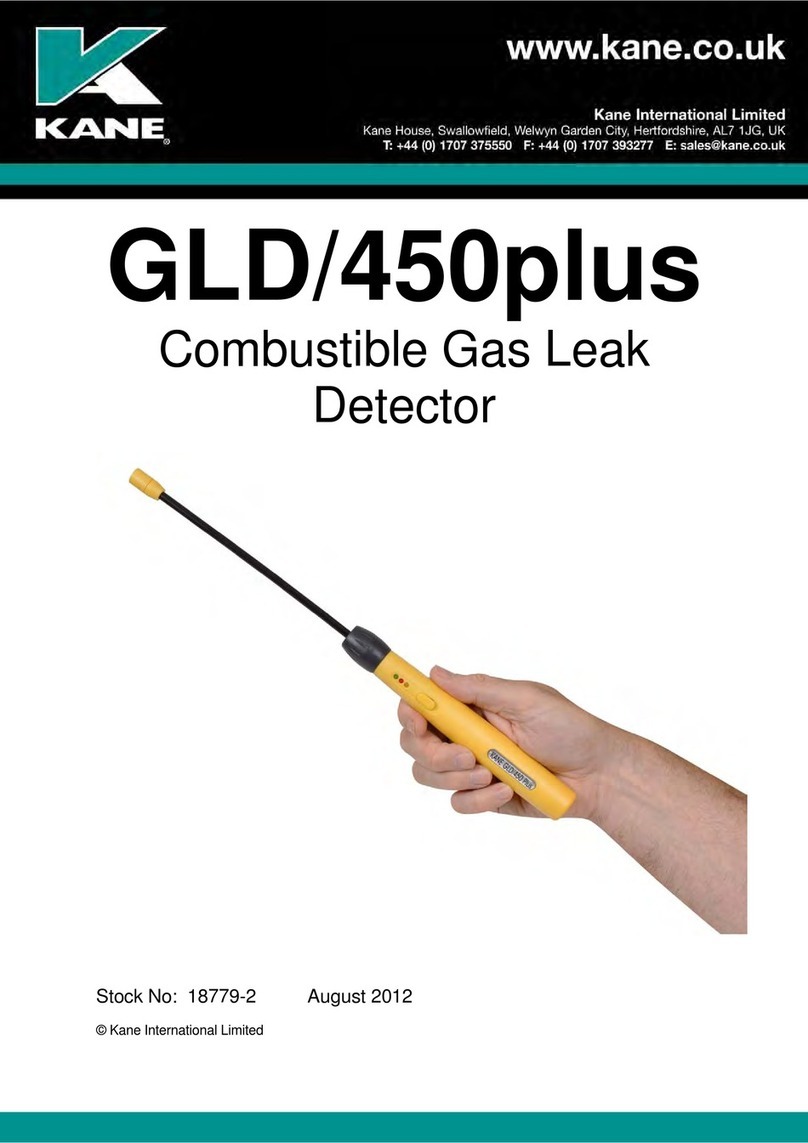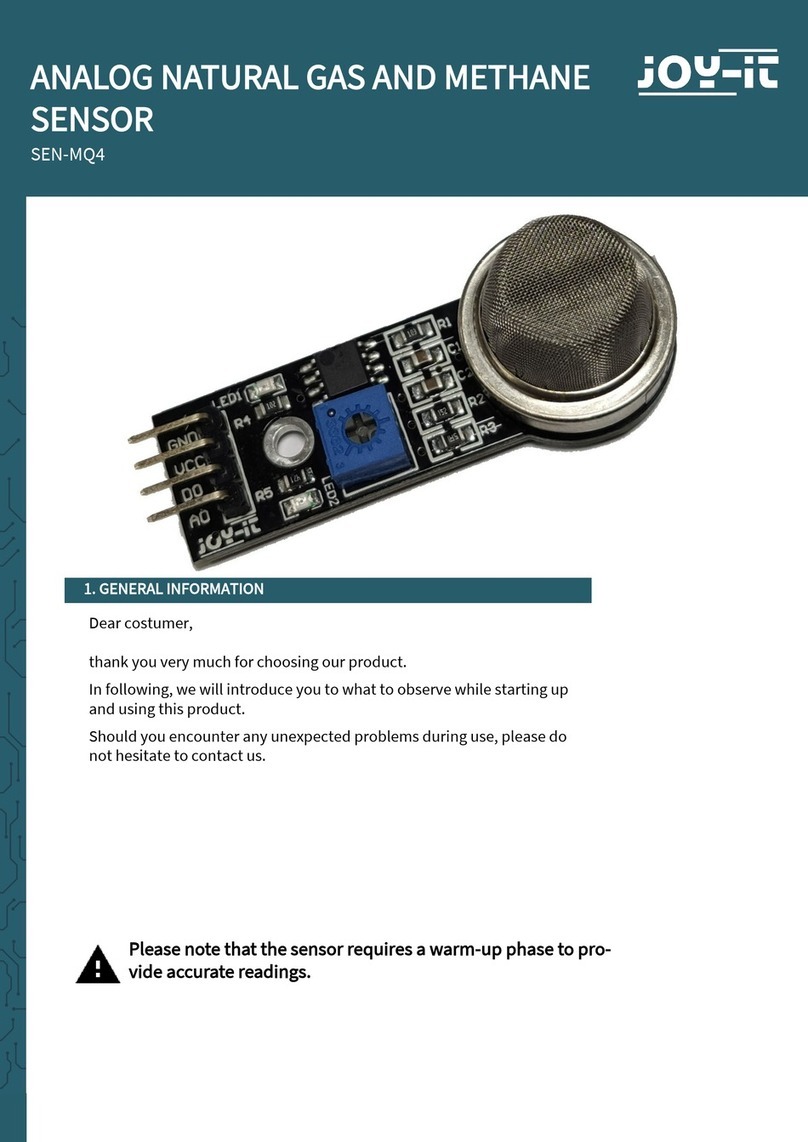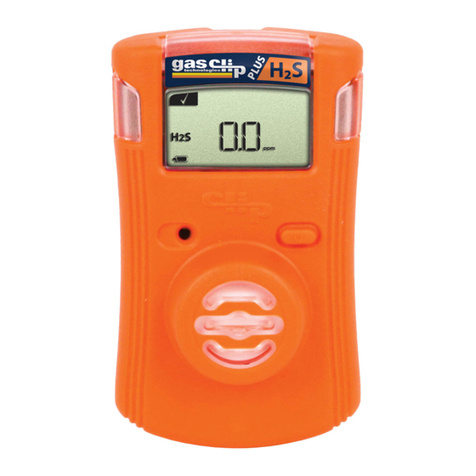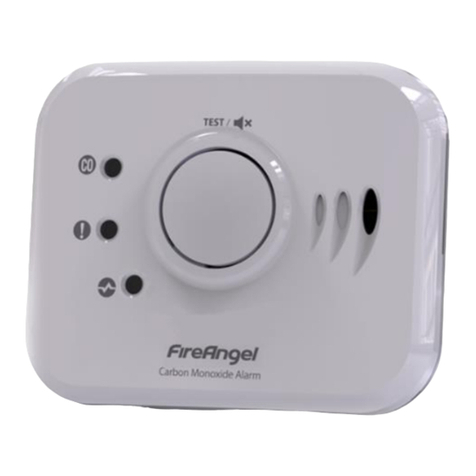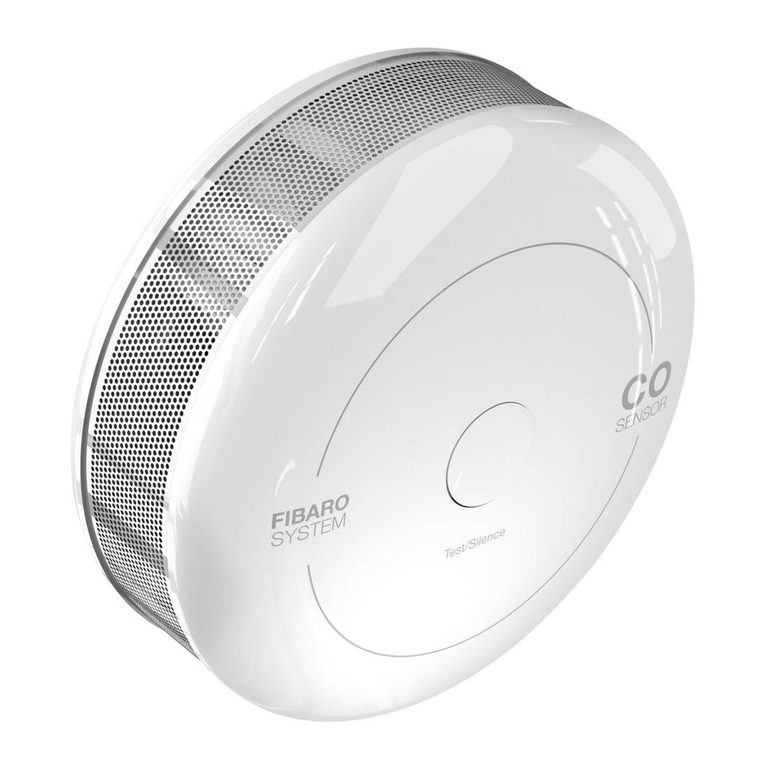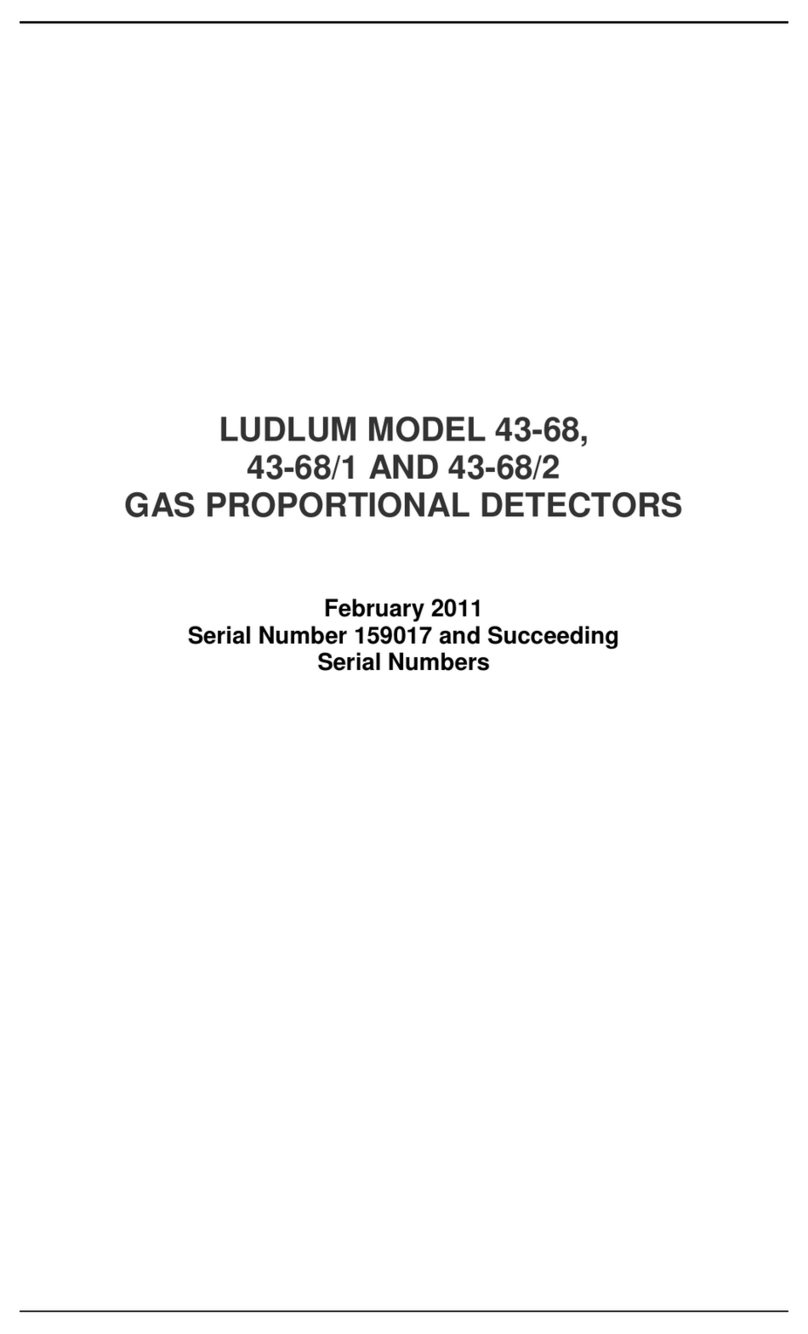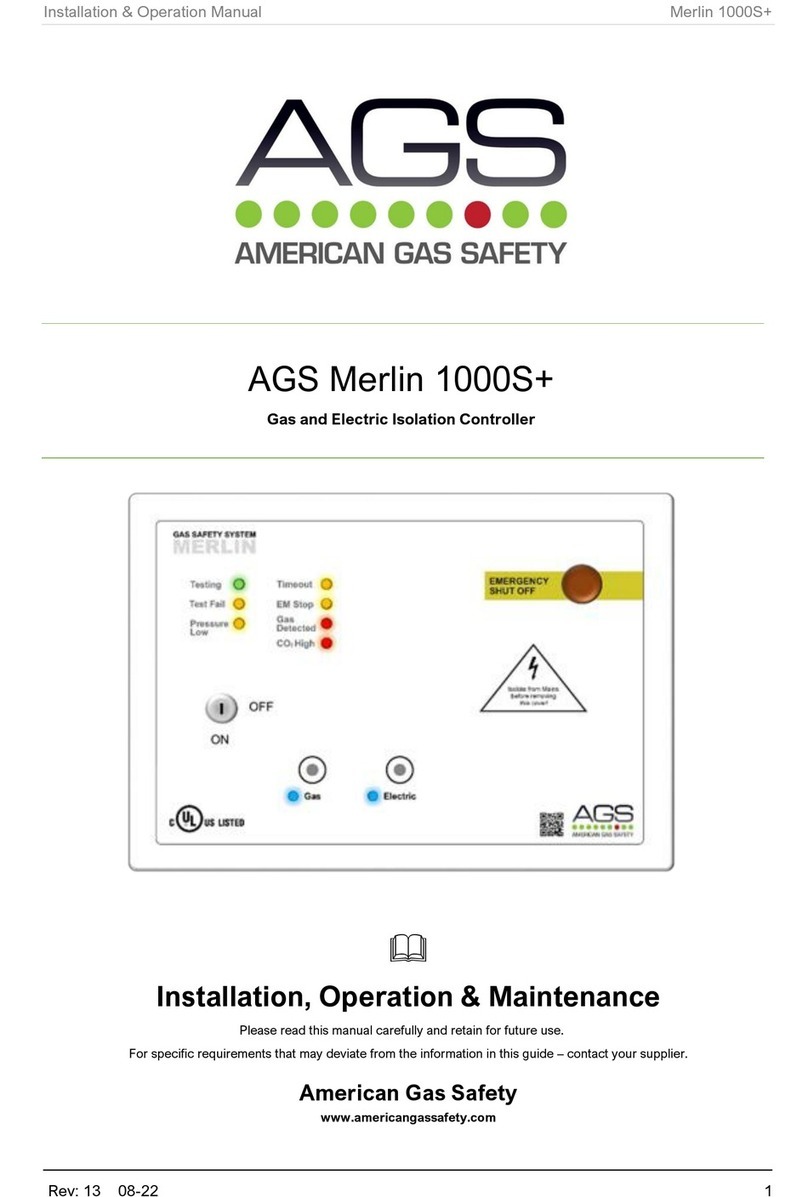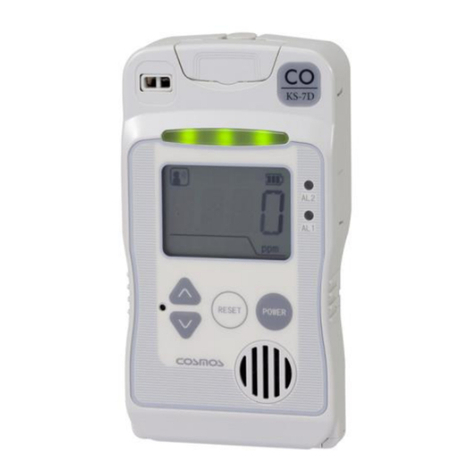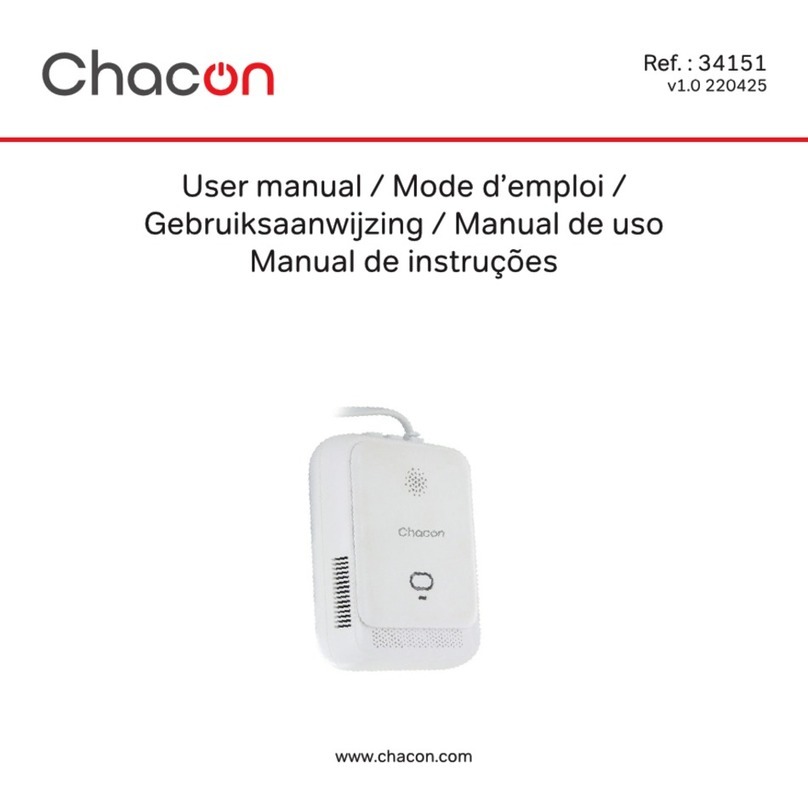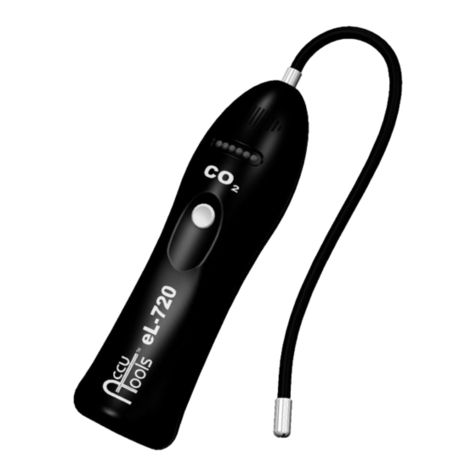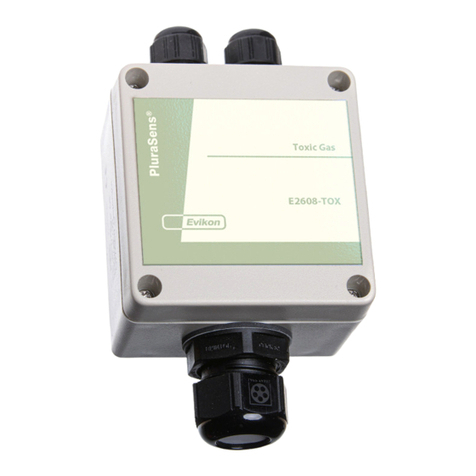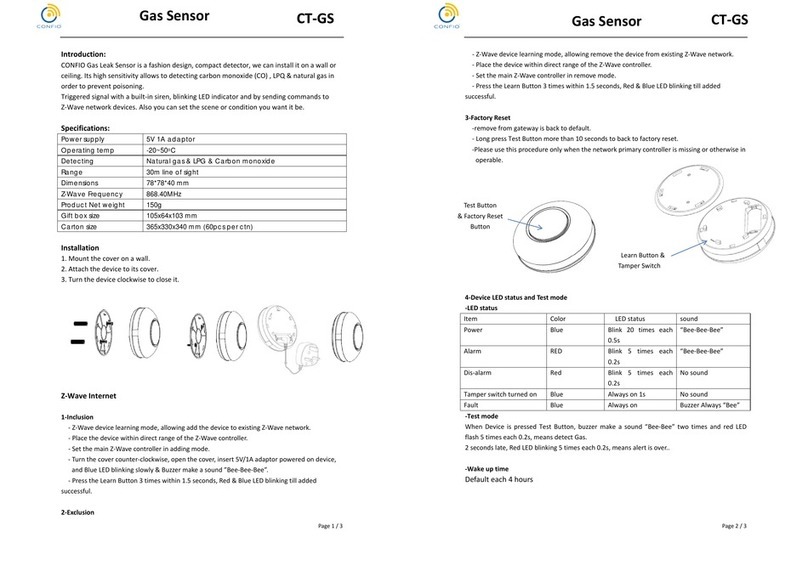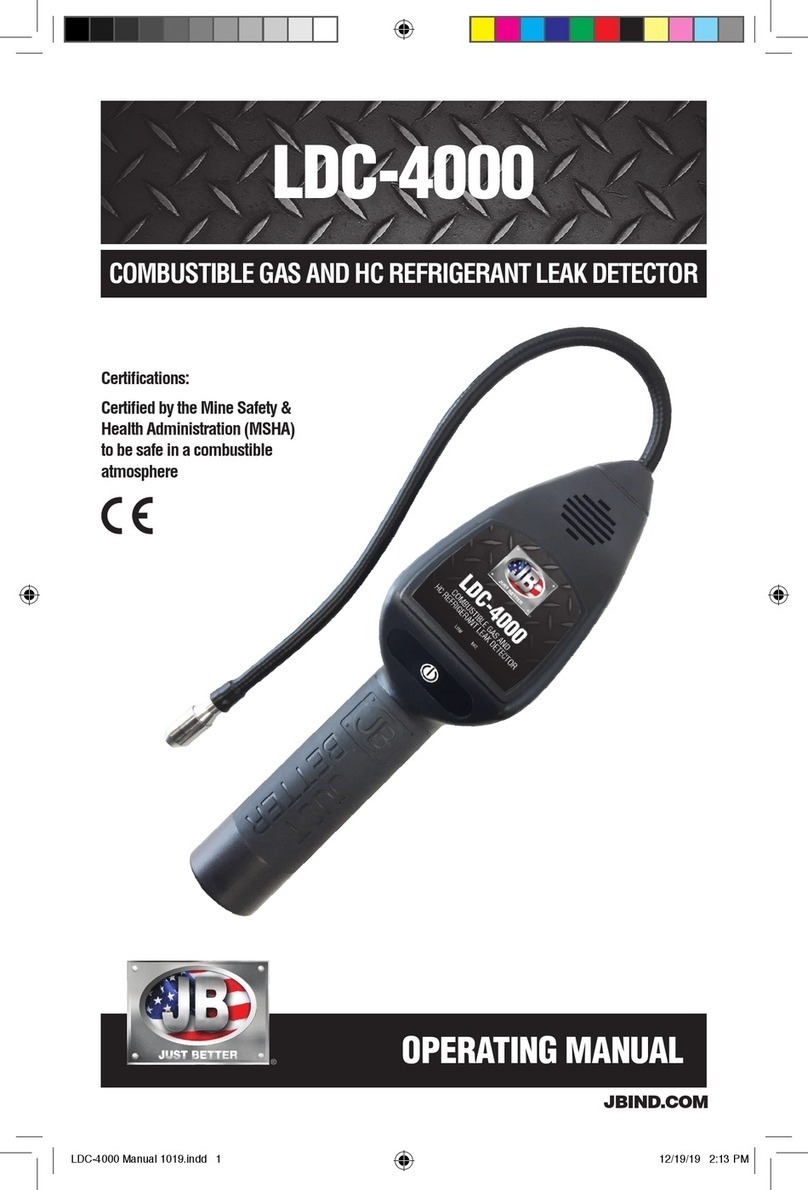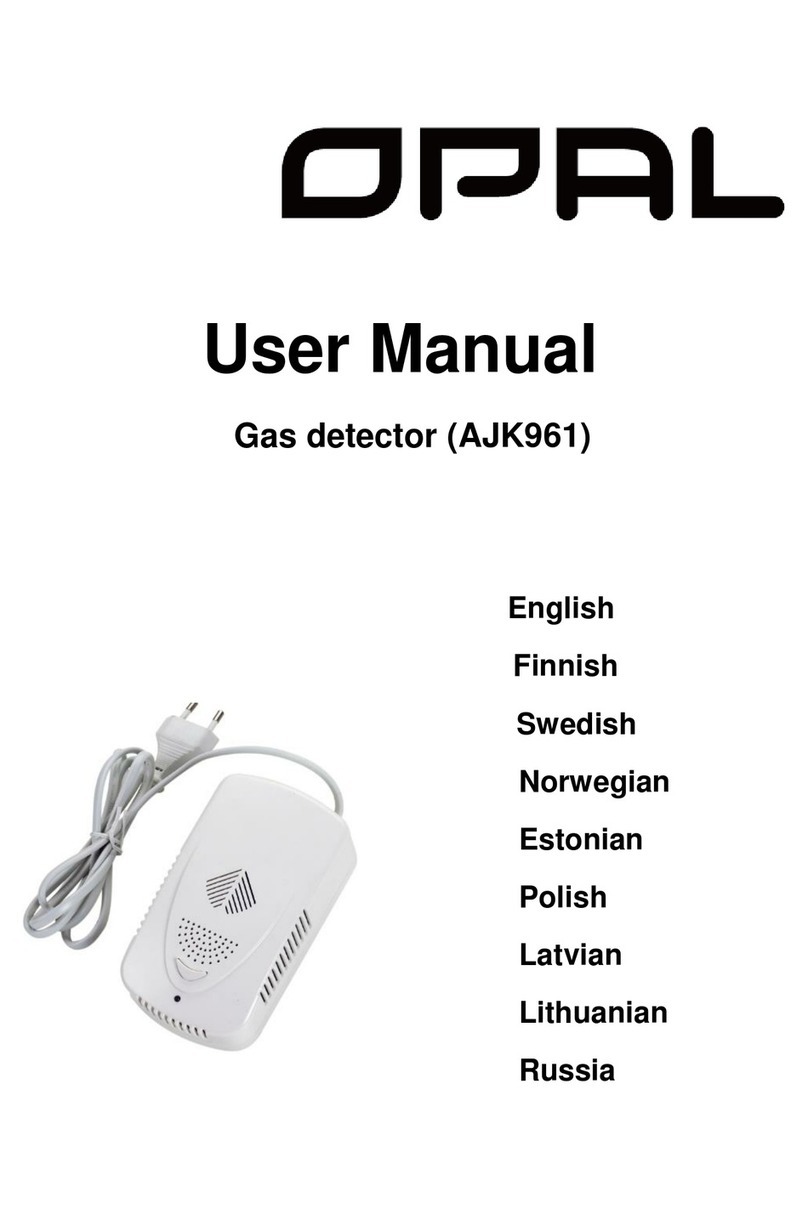STATUS SCIENTIFIC CONTROLS FGD 3 Series User manual

STATUS SCIENTIFIC CONTROLS
Issue:
7
Date:
7/1/20
Firmware:
V9.4i
FGD 3 Infrared
Gas Detector
Stock No. SS412 - Carbon Dioxide
Stock No. SS413 - Hydrocarbon
STATUS SCIENTIFIC CONTROLS LTD.
Hermitage Lane Industrial Estate,
Kings Mill Way,
Mansfield,
Nottinghamshire.
NG18 5ER
England
Tel
: 01623 651381
www.status-scientific.com


STATUS SCIENTIFIC CONTROLS
FGD3 Infrared Detector Heads
Declaration of Conformity
Description of Equipment:
The FGD1-3 Series of Fixed Gas Detectors for the detection of Oxygen, Toxic or Flammable gases.
ATEX Certified intrinsically safe for use in Group IIC hazardous locations.
Directive 2014/34/EU ATEX
The following harmonised standards were used in support of this declaration:
Harmonised Standards:
EN60079-0:2018 Explosive atmospheres - Part 0: Equipment - General requirements.
EN60079-1:2014 Explosive atmospheres - Part 1: Equipment protection by flameproof enclosures “d”.
EN60079-11:2012 Explosive atmospheres - Part 11: Equipment protection by intrinsic safety “i”.
Notified Body for Hazardous Area Certification:
SGS Fimko Oy
Särkiniementie 3
Helsinki, 00211
Notified Body Number: 0598
Notified Body for ATEX Quality Assurance Notification:
SGS Fimko Oy
Särkiniementie 3
Helsinki, 00211
Notified Body Number: 0598
Hazardous Area Certificate Number:
Baseefa 01ATEX2300 II 2 G Ex ia IIC
T4 Gb (-20OC <Ta< +60O C)
ATEX Quality Assurance Notification Number:
2056
Place of Manufacture:
Mansfield, Nottinghamshire, UK. Date mark applied –see product
ISO 9001:2015 Quality Management System:
Certificate No. GB93/1938
2014/30/EU –Electromagnetic Compatibility
Harmonised Standards:
EN50270:2006 Electromagnetic compatibility - Electrical apparatus for the detection and measurement of combustible gases, toxic gases
or oxygen.
Authorised Signatory to this declaration, on behalf of the manufacturer:
Name: David Stuttard Title: Managing Director
Address: Status Scientific Controls Ltd, Hermitage Lane Industrial Estate, Kings Mill Way
Mansfield, Nottinghamshire, NG18 5ER, United Kingdom
Signature Date: 14/10/19
Extract from TD06/110

STATUS SCIENTIFIC CONTROLS
FGD3 Infrared Detector Heads
1FIRMWARE REVISION HISTORY....................................................................3
MAX XREF CHANGED FROM 150 TO 500.2. INTRODUCTION ................................3
2.1 BACKGROUND....................................................................................................5
3INSTALLATION ...............................................................................................6
3.1 SITING THE SENSORS ....................................................................................6
3.2 WIRE TERMINATION.......................................................................................6
3.3 CABLE ROUTING............................................................................................6
3.4 CABLE &SCREENING.....................................................................................7
3.4.1 Connection Instructions.....................................................................7
3.5 INSTALLATION IN A NON-HAZARDOUS LOCATION................................................8
3.6 INSTALLATION IN HAZARDOUS AREAS..............................................................9
3.6.1 Installations using Proprietary Safety Barriers................................. 10
4RELATIVE RESPONSE CHARACTERISTICS...............................................11
5CALIBRATION AND MENU SYSTEM............................................................ 13
rrV ..................................................................................................................13
5.1.1 Calibration Gas Flow Rates.............................................................13
5.2 MENU MODE SELECTION..............................................................................14
5.2.1 C: 1 - Zero Sensor...........................................................................16
5.2.2 C: 2 - Span Sensor..........................................................................17
5.2.3 C: 3 - Select FSD............................................................................18
5.2.4 C: 4 - Set 4mA Loop Current...........................................................18
5.2.5 C: 5 - Set 20mA Loop Current.........................................................18
5.2.6 C: 6 - Display mode.........................................................................19
5.2.7 C: 7 - Display Firmware Version......................................................19
5.2.8 C: 8 - Restore..................................................................................20
5.2.9 C: 9 - View Engineer/Diagnostics Data............................................21
5.2.10 C:10 - Sensor Frequency................................................................21
5.2.11 C:12 - Cross Reference...................................................................22
5.2.12 C: 19 - Positive Zero Suppression...................................................23
5.2.13 C: 20 - Negative Zero Suppression .................................................23
5.2.14 C: 25 –Positive Zero Temperature Compensation..........................24
5.2.15 C: 30 - Set Password......................................................................24
5.2.16 C: 34 –Positive Span Temperature Compensation.........................25
5.2.17 C: 35 –Negative Zero Temperature Compensation ........................25
5.2.18 C: 36 –Negative Span Temperature Compensation .......................26
5.2.19 C: 44 - Signal conditioning ..............................................................26
5.2.20 C: 46 –Response window...............................................................27
5.3 FGD3 HEAD INDICATIONS............................................................................28
5.4 SENSOR REPLACEMENT...............................................................................29
5.4.1 Sensor Electronics Verification........................................................29
6TROUBLE SHOOTING...................................................................................30
7CERTIFICATION............................................................................................ 31
8SPECIFICATION............................................................................................32
8.1 HYDROCARBON...........................................................................................32
8.2 CARBON DIOXIDE LOW RANGE......................................................................32

STATUS SCIENTIFIC CONTROLS
FGD3 Infrared Gas Detector Heads
TD06/024
Issue:
7
Change Note:
1904
Page 3
1 Firmware Revision History
Version 9.4i 12 Sept 2007
CO2E added to sensor list:
0-100% Volume.
Version 9.3i 29 May 2007
Micro controller replaced, old processor out of program memory space.
Added fault detection for loss of power on sensor side. Fault generated instead
of high gas reading.
Enhanced menu items.
Password protection added.
Version 6.83i 03 May 2005
CH4t added to list:
used to select methane scale using the temperature compensated sensor.
Version 6.82i 08 Dec 2004
Default bulb rate of 18, was 14
Default target gas to 40.0
Version 6.81i 26 Nov 2004
New sensor type from Dynament –HCC:
no temperature compensation required.
Version 6.8ir 11 Mar 2004
CO2H sensor added to list bug:
sensor details not actually initialised after selection in menu, fixed
Version v6.7ir 26 Feb 2004
CO2H sensor added to list
Version v6.6ir 9 Sept 2003
Max Xref changed from 150 to 500.

STATUS SCIENTIFIC CONTROLS
FGD3 Infrared Gas Detector Heads
TD06/024
Issue:
7
Change Note:
1904
Page 4

STATUS SCIENTIFIC CONTROLS
FGD3 Infrared Gas Detector Heads
TD06/024
Issue:
7
Change Note:
1904
Page 5
2. Introduction
The FGD 3 Infrared Gas Detector Head incorporates the latest generation of compact
sensors incorporating infrared technology (see section 0).
Warning –Infrared sensors will not detect Hydrogen gas.
There are two current detectors in use, one for Hydrocarbon gases and the other for
Carbon Dioxide.
The Hydrocarbon sensor can be set to either methane or general hydrocarbons. These
two settings use different calculations to convert the sensor signals in to gas readings,
it is important to select the correct gas type to give accurate readings.
The detectors use the industry standard 4-20mA current loop to convey the gas levels
detected to a control unit. This means that under zero gas conditions 4mA is drawn
from the supply, and under full scale gas conditions 20mA is drawn from the supply.
The current varies linearly for gas levels between zero and full scale.
The detector heads require a three-wire connection (see section 3.4). While the loop
current supplies the power required by the detector head electronics within the
detector head, a second supply must be provided to power the infrared sensor and its
associated circuitry.
Additional features of the latest generation of FGD3 Heads include:-
•The terminal block for wire termination is located within an EMC enclosure
within the FGD3 Detector Head. This improves the instruments’immunity to
radio and electromagnetic interference.
•The software has been redesigned to allow more data to be accessed by the
knowledgeable user.
An optional weather guard (Stock No. SS 475) is available for installations exposed to
the atmosphere or contaminants and is also suitable for use in other areas where
hosing down takes place. The weather guard is attached with tamperproof screws to
ensure that it is not inadvertently removed.
2.1 Background
The infrared sensors use the proven non-dispersive infrared principle (NDIR) to detect
and monitor the presence of gases. This technique relies upon the target gas having a
unique, well-defined absorption signature within the infrared region of the
electromagnetic spectrum.

STATUS SCIENTIFIC CONTROLS
FGD3 Infrared Gas Detector Heads
TD06/024
Issue:
7
Change Note:
1904
Page 6
3 Installation
IMPORTANT
The instrument will monitor the gases in the environment after being powered for a few
minutes; however it should be left for a minimum of 2hrs before it is calibrated.
3.1 Siting the Sensors
Mounting positions for detector heads need to be considered individually, some points
for consideration are:
•Ensure all sensors are mounted to allow routine calibration and maintenance to
be carried out as required.
•Ensure the proposed site will not interfere with movement of existing equipment,
e.g. cranes, doors etc
•Install all cables neatly and securely.
•Sensors for detecting gases that are lighter than air should be positioned at a
high level.
•Sensors for heavier than air gases should be located at a low level.
•Avoid siting the sensors adjacent to potential sources of radio frequency
interference, e.g. radio transmitters, control switchgear, motors etc.
•Avoid mounting the instrument where it may be subjected to sudden transients in
ambient temperature (e.g. above a heater/radiator).
3.2 Wire Termination
All connections should be made according to the appropriate sensor or loop diagram
for the configuration required. It is advised that ‘Bootlace Ferrules’ or ‘flat blade crimps’
be used for tidy and reliable connections of wires into the Detector Head connectors.
3.3 Cable Routing
Due to the low signal levels generated by gas detectors it is recommended that all
wiring to the sensors be segregated away from AC mains or other high voltage/power
lines to avoid interference.

STATUS SCIENTIFIC CONTROLS
FGD3 Infrared Gas Detector Heads
TD06/024
Issue:
7
Change Note:
1904
Page 7
3.4 Cable & Screening
The use of a screened cable is recommended for the installation of all detector heads.
The correct strategy for connecting the screens depends upon the area in which the
detector head is to be used (i.e. hazardous/non-hazardous). In all cases the screen
should not be connected at the detector head. Refer to the connection diagrams on the
following pages for further information.
The FGD3 infrared detector heads require a three-wire connection to the control unit:
Sig + current loop to head 8.0-28V (25mA max)
0 0V return to control unit
Pwr + supply for sensor 5.8-7.5V (60mA approx)
The infrared sensor requires a current of typically 60mA but draws this in pulses at a
frequency of 2Hz (approx).
Note:
Sig and + terminals must not be connected together. Although the detector head will
appear to function correctly, it will no longer be able to indicate detected gas levels to
the control unit.
3.4.1 Connection Instructions
With the head disconnected adjust the control unit output so that 5.8 –7.5V can be
measured at the detector head between the wires ‘0‘ and ‘Pwr +’. Connect the head
and ensure that the voltage remains within the limits, readjust if necessary.

STATUS SCIENTIFIC CONTROLS
FGD3 Infrared Gas Detector Heads
TD06/024
Issue:
7
Change Note:
1904
Page 8
3.5 Installation in a non-hazardous location
When a detector head is installed in an area where there is no potential of an
explosive gas hazard present, the cable lengths to the detector are limited solely by
the resistance of the cable. The infrared gas detector requires a minimum of 8.0V at its
Sig terminals, and 5.8V at its + terminal to allow it to operate correctly.
The maximum current loop resistance can be calculated. For systems operating at
20V, the maximum cable loop resistance (Sig) will be:
(Voltage available –minimum voltage) / max current = max loop resistance
(20-8.0) / 0.025 = 480.
The voltage at the + supply needs to be 1 volt greater than the required 5.8V minimum
for every 16Ω of cable resistance. At all times the voltage measured between the +
and 0V terminals at the detector head must fall within the range 5.8-7.5V.
The diagram above shows connection for FGD3 Infrared Detector Head in a non-
hazardous location. The pin numbers shown at the control unit refer to pin numbers on
the Status Scientific Controls input modules within the MCU Control Units.
Refer to the manufacturer if alternative control unit is used.
Note: The control unit
0V is connected to
Earth.
Sig 0 +
Screen
21 Sig
22 +
23
24 0-

STATUS SCIENTIFIC CONTROLS
FGD3 Infrared Gas Detector Heads
TD06/024
Issue:
7
Change Note:
1904
Page 9
3.6 Installation in Hazardous Areas
When used in a hazardous area, the FGD3 detector requires an intrinsically safe (I.S.)
power supply. This can be provided in two ways:
1. By using the MCU Control Unit incorporating the I.S. Output Module Type
FGDIO. The FGDIO module is incorporated within the MCU control unit
enclosure and provides intrinsically safe outputs for all versions of the FGD
range of gas detectors.
2. By using proprietary safety barriers.
When using barriers to create an I.S. supply, certain restrictions are imposed on the
parameters of the interconnecting cables used. These parameters are defined by the
manufacturer of the barrier and limit the maximum capacitance, inductance and
inductance to resistance ratio of the cable. The installation is only intrinsically safe
when the combination of the barrier and connecting cables comply with the
manufacturer’s specification.
As with a non-I.S. installation, the cable length is restricted by the cable loop
resistance. With the introduction of a barrier or the FGDIO module (refer to the MCU
System Installation and Hardware Configuration Manual), the cable loop resistance is
reduced because of the internal resistance of the barrier. The end-to-end resistance of
the barrier must therefore be subtracted from the overall cable loop resistance when
calculating cable lengths.
Barriers must be selected to restrict the parameters of the I.S. supply to the gas
detectors within the following limits:
Terminals
Umax
Imax
Pin
Ci
Li
0V and SIG
30V
0.15A
0.81W
10nF
0
0V and +
7.5V
0.75A
1.4W
9.7F
0
When considering the capacitance and inductance allowable across the barrier output
terminals, note:
There is 10nF and zero inductance between terminals 0V and SIG on any model
of FGD Detector head.
There is an equivalent of 9.7F capacitance and zero inductance between
terminals 0V and + on the FGD3 Infrared gas detector.
Guidance on the correct installation of I.S. systems is provided by EN60079-14:2014

STATUS SCIENTIFIC CONTROLS
FGD3 Infrared Gas Detector Heads
TD06/024
Issue:
7
Change Note:
1904
Page 10
3.6.1 Installations using Proprietary Safety Barriers.
For wiring details refer to manufacturers specific data sheets.

STATUS SCIENTIFIC CONTROLS
FGD3 Infrared Gas Detector Heads
TD06/024
Issue:
7
Change Note:
1904
Page 11
4 Relative Response Characteristics
This section is applicable to FGD3 gas detectors fitted with an infrared Hydrocarbon
sensor.
Unless otherwise specified, the FGD3 infrared hydrocarbon gas detector is calibrated
to provide an output signal linearised for methane (CH4) during manufacture.
However, the gas detector will also respond to a range of hydrocarbon gases. The
characteristics shown on the following page demonstrate the relative response to
some of the common hydrocarbons.
If the expected target gas is other than methane then either:-
a) The characteristics can be used as a guide when setting up the alarm levels in the
associated control unit, e.g. where a general hydrocarbon response is required.
b) The FGD3 can be calibrated using a test gas for any of the gases shown in the
characteristic, using the span setting procedure as described in Section 5.2.2
Note: the correct sensor type must be used to match the gas type.

STATUS SCIENTIFIC CONTROLS
FGD3 Infrared Gas Detector Heads
TD06/024
Issue:
7
Change Note:
1904
Page 12

STATUS SCIENTIFIC CONTROLS
FGD3 Infrared Gas Detector Heads
TD06/024
Issue:
7
Change Note:
1904
Page 13
5 Calibration and Menu System
The recommended calibration interval is 6 months. Under no circumstances should it
exceed 12 months.
Important
Whenever the menu system is entered the instrument will cease to indicate the
gas levels that it detects to the control unit. However normal operation is always
returned following a period of keypad inactivity (or when the menu system is
exited).
In order to gain access to the calibration switches and test points, release the screw
situated between the letters A and T of the chrome STATUS label on the Detector
Head front panel. The screw does not need to be completely removed, only release it
far enough so that the STATUS label can rotate revealing the calibration switches and
test points. The buttons and test points are designated as follows:
The keypad has the following functionality:
Button
Function
Alternate Function
MENU
Open / Close Menu
PASSword
UP
Next / Increase
1
DOWN
Previous / Decrease
2
ENTER
Accept selection
3
Note:
Where possible, disable the channel at the control unit so that the calibration feature
used does not cause an alarm condition to be indicated. Refer to control unit
manufacturers’ user manual for further details.
5.1.1 Calibration Gas Flow Rates
The infrared sensors are known to be sensitive to pressure transients and therefore it
is important that the flow rate of gas into the sensor housing is not excessive during
calibrations. Care must also be taken to ensure the exhaust from the sensor housing is
not restricted. The recommended flow rate of calibration gases is 500 - 750cc/min.
r
r
V
UP DOWN TP1 TP2 ENTER MENU
+
-
V

STATUS SCIENTIFIC CONTROLS
FGD3 Infrared Gas Detector Heads
TD06/024
Issue:
7
Change Note:
1904
Page 14
5.2 Menu Mode Selection
The FGD3 uses a password system to restrict the end user from carrying out certain
changes that may compromise the use of the equipment.
If the password system is enabled then the user only has access to calibrate the
sensor and set the 4 - 20 mA without a password.
If the password system is disabled or the Engineer password is entered then complete
access is allowed which gives the user access to every aspect of the system to be
changed.
Note : The password is a pre-set six digit number which can be obtained from
Status Scientific Controls Ltd.
Several calibration modes exist in the FGD3 and these are accessible via the
instruments simple menu system. To select a calibration mode follow this procedure:
•Press the MENU button, either PASS or C: 1 appears on the display. If
PASS appears on the display then either press MENU again or the 6-
digit password.
•Press UP or DOWN until the required menu option is displayed.
•Press ENTER to select the calibration mode.
•To exit the menu press MENU.
While the instrument is in menu mode –any data displayed on the screen will alternate
between the menu number and the reading.

STATUS SCIENTIFIC CONTROLS
FGD3 Infrared Gas Detector Heads
TD06/024
Issue:
7
Change Note:
1904
Page 15
The following features are available via the ‘FGD3’ menu system: -
Menu
item
Function
Section
1
Zero Sensor
5.2.1
2
Span Sensor
5.2.2
3
Set FSD
5.2.3
4
Set 4mA loop current
5.2.4
5
Set 20mA loop current
5.2.5
6
Set Display mode
5.2.6
7
Display Firmware Version
5.2.7
8
Restore data
5.2.8
9
View Engineer/Diagnostic data
5.2.9
10
Sensor frequency
5.2.10
12
Set cross reference
5.2.11
19
Set Positive zero suppression
5.2.12
20
Set Negative zero suppression
5.2.13
25
Set zero temperature compensation
5.2.14
30
Password control
5.2.15
34
Set span temperature compensation
5.2.16
44
Set signal conditioning
5.2.19
46
Set response window
5.2.20
Note: Menu modes 1,2,4 & 5 are always available. The remaining menu items are
under the password control. If the password is enabled then a valid password
is required to gain access to the extra menu items, including the password
menu.

STATUS SCIENTIFIC CONTROLS
FGD3 Infrared Gas Detector Heads
TD06/024
Issue:
7
Change Note:
1904
Page 16
5.2.1 C: 1 - Zero Sensor
This is a calibration feature. It allows the instrument to determine the sensor output
under zero gas conditions.
•Apply zero gas to the sensor inlet and allow enough time for the sensor to
respond and all the gas to be purged (typically 2 minutes minimum
dependent upon flow rate).
•Select menu mode C: 1 (refer to section 5.2) and press ENTER.
•Press ENTER to perform the ZERO calibration. Pressing MENU instead of
ENTER aborts the calibration (the ZERO factor will still be displayed on exit).
•Press MENU –the display will show the ZERO factor for the instrument
before returning to its standard mode of operation.
The ZERO factor should be recorded on any calibration certificates completed.
Note: For Hydrocarbon sensors
If there is 0% Hydrocarbon gas present in the atmosphere then the instrument can be
zeroed in air.
Note: For Carbon Dioxide sensors
There is Carbon Dioxide gas present in the atmosphere and as such zero gas must be
applied before the instrument can be zeroed.

STATUS SCIENTIFIC CONTROLS
FGD3 Infrared Gas Detector Heads
TD06/024
Issue:
7
Change Note:
1904
Page 17
5.2.2 C: 2 - Span Sensor
This is a calibration feature. It allows the instrument to determine the sensor output
when it is exposed to a know concentration of gas.
•Apply a known concentration of gas to the sensor inlet and allow enough
time for the sensor to respond.
•Select menu mode C: 2 (refer to section 5.2) and press ENTER.
•Using the UP and DOWN buttons, adjust the displayed reading so that it
matches the calibration gas concentration.
•Press ENTER to perform the SPAN calibration. Pressing MENU instead of
ENTER aborts the calibration (the SPAN factor will still be displayed on exit).
•Press MENU –the display will show the SPAN factor for the instrument
before returning to its standard mode of operation.
The SPAN factor should be recorded on any calibration certificates completed.
5.2.2.1 Suggested calibration gas levels.
Hydrocarbon sensor: (refer to section 1)
20 to 50%LEL Methane
20 to 50%LEL Propane
20 to 50%LEL Pentane
Carbon Dioxide sensor
1 to 2% vol. Carbon Dioxide
5.2.2.2 Calibration Factors
During the ZERO sensor and SPAN sensor calibrations a factor is displayed that
allows the calibration personnel to have confidence with their calibration.
The ideal ZERO and SPAN factors are as follows:-
Sensor
Factor
MIN
TYP
MAX
HC
Zero
TBA
1.850
TBA
HC (Pentane)
Span
TBA
0.660
TBA
HC (Methane)
Span
TBA
0.140
TBA
Carbon Dioxide
Zero
TBA
0.75
TBA
Span
TBA
0.42
TBA
Table of contents
Other STATUS SCIENTIFIC CONTROLS Gas Detector manuals
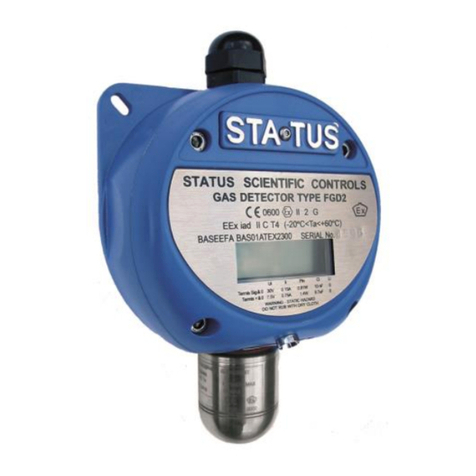
STATUS SCIENTIFIC CONTROLS
STATUS SCIENTIFIC CONTROLS FGD2 User manual
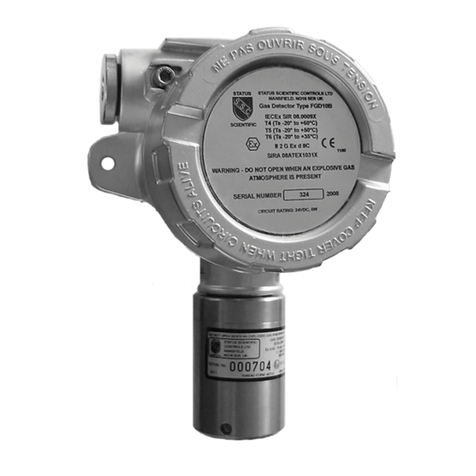
STATUS SCIENTIFIC CONTROLS
STATUS SCIENTIFIC CONTROLS FGD10B Series User manual

STATUS SCIENTIFIC CONTROLS
STATUS SCIENTIFIC CONTROLS FGD10B Series Guide
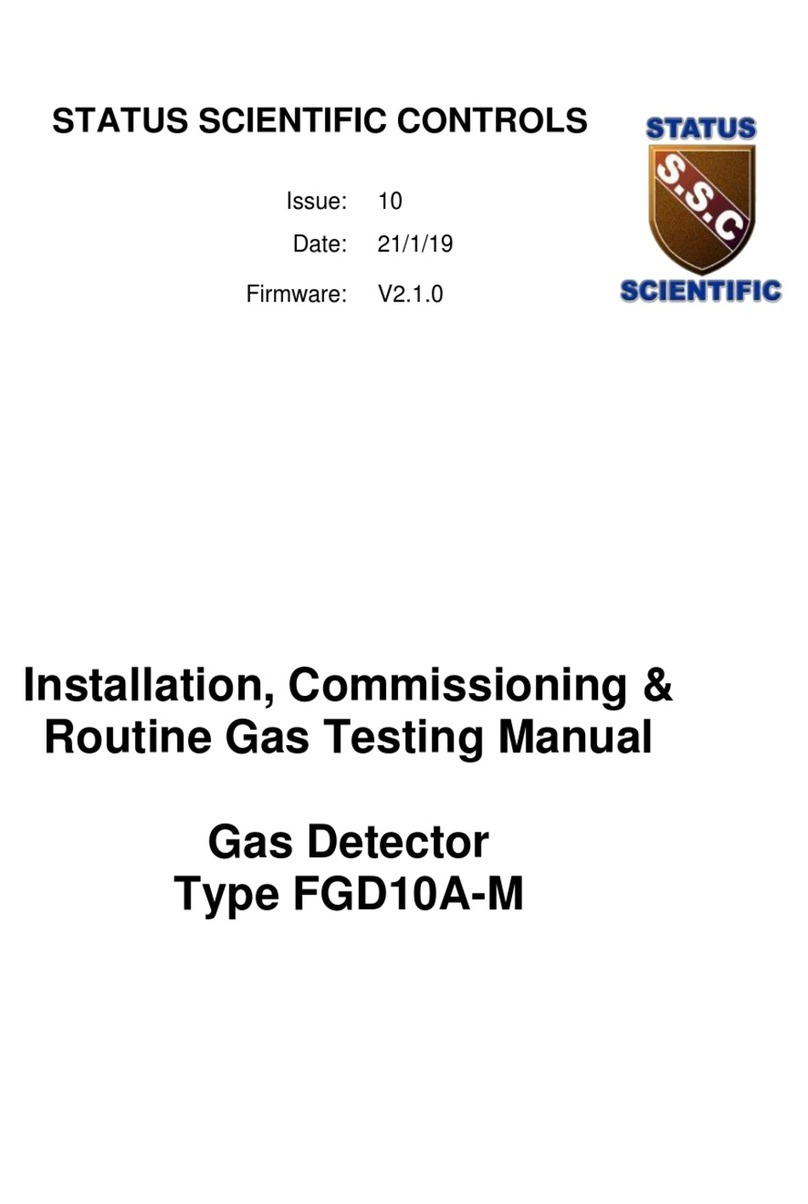
STATUS SCIENTIFIC CONTROLS
STATUS SCIENTIFIC CONTROLS FGD10A-M User manual

STATUS SCIENTIFIC CONTROLS
STATUS SCIENTIFIC CONTROLS FGD10A User manual
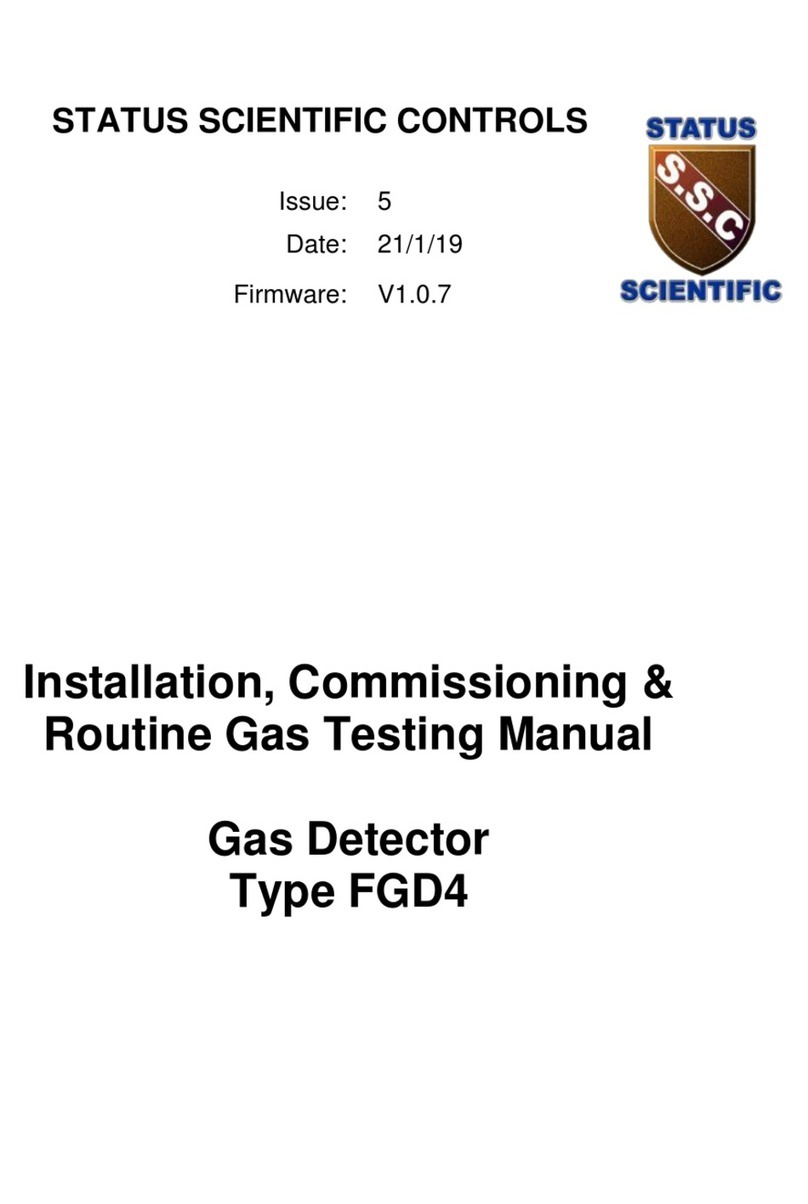
STATUS SCIENTIFIC CONTROLS
STATUS SCIENTIFIC CONTROLS FGD4 User manual

